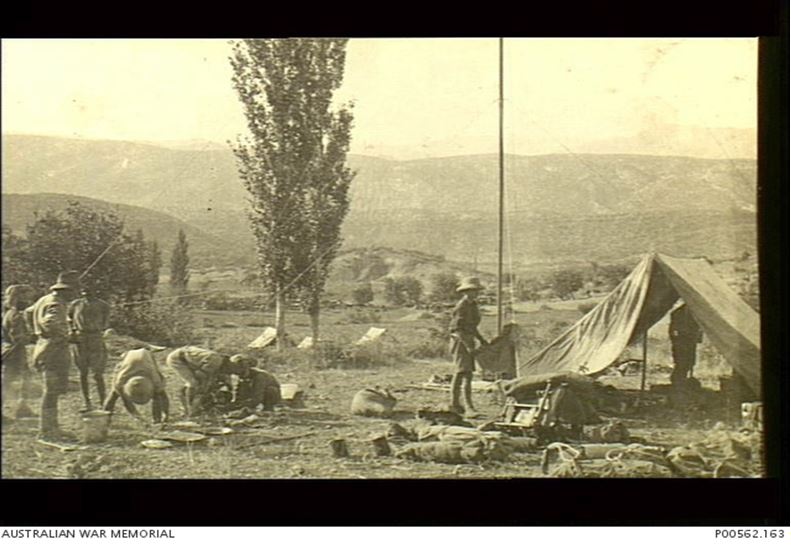Arthur Reginald Barrett
From Our Contribution
 | |
 Hazie, Amadia (Amadya), Kurdistan, (August) 1919 Members of No. 14 Station, `D' Troop, 1st Wireless Signal Squadron, with their gear outside a tent near Masurka Gorge; note the wireless mast beside the tent. The station was supporting Major General Nightingale's Column (Nightcol) of the 18th Division, Mesopotamian Expeditionary Force. AWM photo P00562.163 | |
| Personal Information | |
|---|---|
| Date of Birth | 29 Aug 1899 |
| Place of Birth | St John's Wood, London, England |
| Death | 4 Oct 1980 |
| Place of Death | Narrogin, Western Australia |
| Age at Enlistment | 18 years, 2 months |
| Description |
5'6¼" (1.68m) tall ; 120lbs 54.431 kg ; fair complexion ; blue eyes ; brown hair |
| Occupation | Window dresser |
| Religion | Church of England |
| Address | 'Beechwort', Station road, Gosnells, Western Australia |
| Next of Kin | Father , Mr Frederick Barrett |
| Military Information | |
| Reg Number | 23021 |
| Date of Enlistment | 25 Oct 1917 |
| Rank | Sapper |
| Unit/Formation | 1st Australian & New Zealand Wireless Signal Station |
| Date of Embarkation | 14 Sep 1918 ‒ 23 Oct 1918 |
| Ship Embarked On | SS Port Darwin |
| Date of Embarkation | 17 Oct 1918 ‒ 28 Oct 1918 |
| Ship Embarked On | HMT Egra |
| Date of Return | 5 Nov 1919 ‒ 11 Nov 1919 |
| Ship Returned On | SS Varela |
| Date of Return | 1 Dec 1919 ‒ 22 Dec 1919 |
| Ship Returned On | HMAT A7 Medic |
| Fate | Returned to Australia |
| Monument | Gosnells Road Board Honour Roll |
| Medals |
British War Medal Victory Medal General Service Medal 1918-1962 Australian Service Medal 1939-45 |
Contents
[hide]Pre War
Arthur Reginald Barrett was born in St John’s Wood, London on 29 Aug 1899 and baptized on 3 Dec 1900 at St. John’s All Saints, Westminster. Together with his parents and five siblings he departed London for Australia on 19 Aug 1911 aboard the SS Papanui.
War Service
Artur enlisted in Hay Street Perth on 25 Oct 1917, and following basic training in Western Australia, and a period of leave from 12 - 17 Jan 1918, Arthur was sent to the Army Signals School at Moore Park in New South Wales. On 7 Feb 1918 he became a member of the Wireless Station reinforcement draft for Mesopotamia. On 3 Sep 1918 he was admitted to the Field Hospital in Liverpool New South Wales with influenza, before being discharged on 5 Sep 1918.
The reinforcements embarked from Sydney on the SS Port Darwin, and were transshipped at Bombay in India. They disembarked at Basrah (Iraq) on 23 Oct 1918 from HMT Egra. On arrival he entered camp at Margil, before joining his unit in Baghdad on 16 Nov 1918.
On 14 Dec 1918 he was admitted to the 31st Stationary Hospital in Baghdad with dysentery, and was discharged to duty on 30 Dec 1918. Admitted to hospital again on 23 Sep 1919 at Zakho with a fever, before being released on 1 Oct 1919. Arthur was one of 45 Australians serving with the 1st Wireless Signal Squadron, which was involved in the operations in central Kurdistan between 14 July and 7 October 1919 which gave rise to the award of his General Service Medal 1918-62 with the clasp Kurdistan. With the withdrawal of Turkish troops from this part of Mesopotamia, British Imperial forces filled the void to pacify the Arab revolt which was active throughout northern and central Kurdistan led by the Kurdish Chief Sheikh Mahmoud. On 5 Nov 1919 he embarked on the SS Varela for Bombay arriving on 11 Nov 1919. On 1 December he embarked on HMAT A7 Medic for Australia. Arthur was discharged by the 5th Military District on 6 Jan 1920.
Post War
Arthur returned to his pre-war job as a window dresser and resided at 5 Victoria Street, South Perth. He moved to Yilliminning and became a farmer and on 16 Jan 1926 married Charlotte Beatrice Farrell in St George's Cathedral in Perth. Charlotte was born in 1903 and died in Narrogin on 13 Jun 1994 aged 91. They had two daughters, Joan Paula (29 Nov 1926 - 1999) and Beverley Bernard (1931 - 2010).
On 12 May 1941 at Narrogin, WA Arthur joined the 10th (Narrogin) VDC Battalion, serving from 12 May 1941 to 8 Mar 1946. Arthur attended a K.P.S. course at Guildford in July 1941; and on 28 Jul 1941 was appointed Captain with the 10th (Narrogin) VDC Battalion. He attended a Battalion Commanders course at Melville from 5 - 17 Oct 1942, and then a course for Captains at the 3rd Australian Corps Signal Training Centre from 17 July 1943 to 30 July 1943. Appointed to Command the 10th (Narrogin) VDC Battalion on 1 Jan 1944, he was promoted Temporary Major on 25 January 1944, with the rank confirmed on 27 Sep 1945. Arthur relinquished Command of the battalion on 8 Mar 1946 when he was placed on the Reserved List with his appointment terminated on 15 Mar 1946. In 1949 he would have received the Australian Service Medal.
From 1954 to 1968 Arthur and his wife were residing in Safety Bay. He died in Wellington WA in 1980 aged 81. He is not on the Gosnells RSL Roll
Western Australia, PARTNERSHIP ACT, 1895. Notice of Dissolution.NOTICE is hereby given that the partnership lately existing between Arthur Reginald Barrett, of Yilliminniag, farmer, and Thomas Ashley, of Angelo Street, South Perth, accountant, both in the State of Western Australia, under the firm name of "Barrett & Ashley," has been dissolved as from the 14th day of August, 1925, and the business of farmers hitherto carried on by the partnership at Yilliminniag will be continued by the said Arthur Reginald Barrett alone, and the said Arthur Reginald Barrett is entitled to receive all moneys on behalf of the partnership and will pay all partnership debts as they fall due. Dated the 20th day of October, 1925.
A. R. BARRETT[1]
Post Office Directories: 1925 - 1948 Yilliminning (east of Narrogin); 1954 - 1958 Gloucester crescent, Safety Bay; 1968 at 150 Arcadia West, Safety Bay.
During WW2 Arthur enlisted on 27 May 1942 and served with the 10th (Narrogin) VDC Battalion at Narrogin until 15 Mar 1946 with the rank of Captain, with regimental number W73802.
Notes
For more information about the history and heritage of the City of Gosnells, please contact the Heritage Coordinator on 9391 6011
- Jump up ↑ Government Gazette WA 13 Nov 1925 page 2302